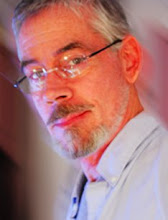Two things intrigued me about this world: the digital camera could record information in very low light levels, information that could then be expanded in photoshop, and also, the images themselves were immediately available in multiples to be compounded in ways that allowed for shifts in point of view that greatly expanded the information that could be put into a single image. I started taking pictures under increasingly dark condition- often the image would not be discernible, and then processing them in photoshop to bring an image out of the darkness. I likened this to Raku, you wouldn't really know what would happen and you had to work with what started to develop. For the first time in my life as an artist I was producing abstract images, and using photography to do so.
I also did a series of portraits of friends who came to visit. I kept the light low, and the camera I was using at the time produced rather blurry images that I would then draw detail into. When I paint a figure I usually keep the mass rather vague, and then, at the end of the process I would add a few careful highlights and a few defined lines to make the form "pop." I found myself doing this in photoshop, and it worked. On one of these I was having trouble with the color, and I started playing with layers of solid color, maybe I could do a duo tone and forget the color problem, and one layer that I tried was an earth green, I adjust the transparency, and suddenly I had what traditional painting calls "optical grays." I was stunned! The tricks of image making that I had learned by years of study of old master paintings worked perfectly well in photoshop. I was using the newest digital technology to created my very old fashioned paintings!
"What old fashion could that be, Paul wondered with a palpitating heart," Like Paul in "Dombey and Sons" by Dickens, I was wondering with a palpitating heart what was old or new fashioned as I was playing with this new technology, channeling Dürer and Velasquez while taking color channels apart and applying gradient maps in photoshop! As dark as the first half of the first decade of the new millennium was for me personally I am firmly convinced that the wonder and excitement of this new way of expressing myself is what got me through.
I produced a series of abstractions, a series of totally abstracted figures and portraits (hats off to some very patient friends) and when I started to be able to walk about again some interesting landscapes that are very obviously manipulated.
In 2008 I was doing a lot of landscape images. I was walking a lot at that time, and would use the parks around Boston, particularly the Fenway, Muddy river and Arnold Arboretum as raw material for rather pastoral images. They were a vehicle for developing my interest in way of constructing images in what I was starting to think of as "irritating the eye." The process of seeing is extremely complex, and is not a reading by the brain of a static image. Our brain is constantly interpolating information from our roving eyes and constructing a surprisingly dynamic image of this constantly changing information. I recommend the work of Semir Zeki, Oliver Sacks, and Dr. Land as a source for this. If you look closely at an eighteenth century steel engraving- completely representational images, and also at certain newspaper pages where the color plates are just slightly off register, you will see how the two dimensional images we process are often composed of nothing but interference patterns. This in fact was one of Dr. Lands great experiments, he used a black and a red transparency to project a full color image. We interpret color not by reading a light frequency but by interpolating between two frequencies.
To me this is all pretty interesting stuff, and experiments in the color channels of my images was what I was mainly focused on, the result being these pretty pastoral images with (I hope) a kind of dynamic vibration that makes them live. I don't intend the viewer to be conscious of the trick, only to be affected by the result.
In fact what I was doing was taking a picture, then editing the image to conform to what I thought of as beautiful- out with those telephone poles- and then doing my processing on the image of this fictional beautiful place. One of the questions I asked in the previous post contains a challenge. The alley behind the house I live in always seems magical to me. Walking through it is always wonderful, beautiful, but it contains all sorts of trash cans and hanging wires. I could- indeed I have, taken pictures in the alley and use photoshop to edit out all those offensive things, but could I put the beauty I experience in an image without removing them? To make the question more specific, could I make a beautiful image of this alley I love so much, rather than creating a fiction about a beautiful place and then making an image of the fiction?
That became my challenge in August of 2008. How I responded to that Challenge is the series of images contained in "A portrait of August." This at least is the formal challenge. There were others as well.





